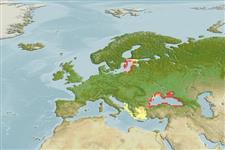Common names from other countries
分类 / Names
俗名 | 同种异名 | Catalog of Fishes(属, 种) | ITIS | CoL | WoRMS | Cloffa
Teleostei >
Gobiiformes (Gobies) >
Gobiidae (Gobies) > Gobiinae
Etymology: Neogobius: Greek, neos = new + Latin, gobius = gudgeon (Ref. 45335).
More on author: Pallas.
Environment: milieu / climate zone / depth range / distribution range
生态学
海洋; 淡水; 半咸淡水 居于水底的; 非产卵性溯降河的 (Ref. 46888); 深度上下限 0 - 30 m (Ref. 36771). 溫帶; 4°C - 20°C (Ref. 2059); 60°N - 36°N, 18°E - 58°E
Europe and Asia: Sea of Azov, Black Sea and Caspian basins. Adverse ecological impact after introduction have been reported by several countries. In 2004, this was accidentally introduced in North America with ballast water in ships (Ref. 59043).
歐洲: 亞速海, 黑海與里海的流域。 引入後的不利的生態衝擊曾經被一些國家報告。
Length at first maturity / 大小 / 重量 / 年龄
Maturity: Lm ?, range 4 - ? cm
Max length : 35.0 cm TL 雄鱼/尚未辨别雌雄; (Ref. 88073); 最大体重: 381.42 g (Ref. 88073); 最大年龄: 6 年 (Ref. 110985)
背棘 (总数) : 7 - 8; 背的软条 (总数) : 12 - 17; 臀棘: 1; 臀鳍软条: 9 - 14; 脊椎骨: 31 - 34. This species is distinguished from its congeners entering freshwater in Europe by the following characters: first branched ray of second dorsal about as long as penultimate ray; no scales on midline of nape, in front of preoperculum; pelvic-disc fraenum with small rounded lobes and the length is less than 1/6 of width at base; scales in midlateral series 45-54 + 2-3; a large black spot on the posterior part of first dorsal (Ref. 59043).
Prefer shallow, brackish waters but also occur in fresh waters (Ref. 36771); in lagoons and lakes, large rivers, harbors, on sand or rock bottom; mostly found on well vegetated or rock bottom (Ref. 59043). Can tolerate a temperature range of 0 to 30°C, but mainly thrive in warm
temperate waters; able to tolerate low oxygen content waters for several days (Ref. 36771). Oviparous, with demersal eggs (Ref. 36771). Longevity up to 4 years. Males reproduce for the first time at 3-4 years, females at 2-3 years. Spawning season in April to September; females may repeat spawning during a season, every 18-20 days; body of males entirely black during this season. Adhesive eggs deposited on stones, shells and aquatic plants; males guard eggs until hatching and usually die after spawning season. Egg clutches are supposed to be occasionally transported attached to the hull of ships, facilitating introduction to other areas. Feeds on a wide variety of invertebrates and small fish, mostly on molluscs (Ref. 59043). Due to its large size, it has a major commercial value in some areas, especially in Azov Sea. It is usually salted, dried and consumed with beer (Ref. 92840).
偏爱浅滩, 半咸淡水域也出现在淡水.(参考文献 36771) 生活在石头上; 在淡化的区域与河口中.(参考文献 2058) 能容忍一个 0 到 30 °C 的温差, 但是主要地在暖温带水域中繁荣.(参考文献 36771) 能容忍低溶氧量水域长达好几天.(参考文献 36771) 卵生的,具有沉性卵.(参考文献 36771) 雄性在产卵季节之后保护胚胎与稚鱼而且死。 (参考文献 36771)
Males protect embryos and juveniles (Ref. 36771). Males die after the spawning season (Ref. 36771).歐洲: 亞速海, 黑海與里海的流域。 引入後的不利的生態衝擊曾經被一些國家報告。
Kottelat, M., 1997. European freshwater fishes. An heuristic checklist of the freshwater fishes of Europe (exclusive of former USSR), with an introduction for non-systematists and comments on nomenclature and conservation. Biologia, Bratislava, 52/Suppl. 5:1-271. (Ref. 13696)
CITES (Ref. 128078)
Not Evaluated
人类利用
渔业: 商业性; 水族馆: 商业性; 诱饵: occasionally
工具
特别资料
下载 XML
网络资源
Estimates based on models
Preferred temperature (Ref.
115969): 8.1 - 16.4, mean 14.2 (based on 168 cells).
Phylogenetic diversity index (Ref.
82804): PD
50 = 0.5625 [Uniqueness, from 0.5 = low to 2.0 = high].
Bayesian length-weight: a=0.01122 (0.00950 - 0.01325), b=3.04 (2.99 - 3.09), in cm Total Length, based on LWR estimates for this species (Ref.
93245).
营养阶层 (Ref.
69278): 3.3 ±0.1 se; based on diet studies.
回复力 (Ref.
120179): 中等的, 族群倍增时间最少 1.4 - 4.4年 (tm=2-4; tmax=4; Fec=300).
Fishing Vulnerability (Ref.
59153): Low to moderate vulnerability (26 of 100).
